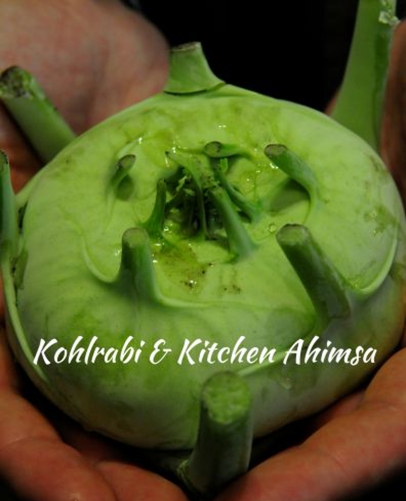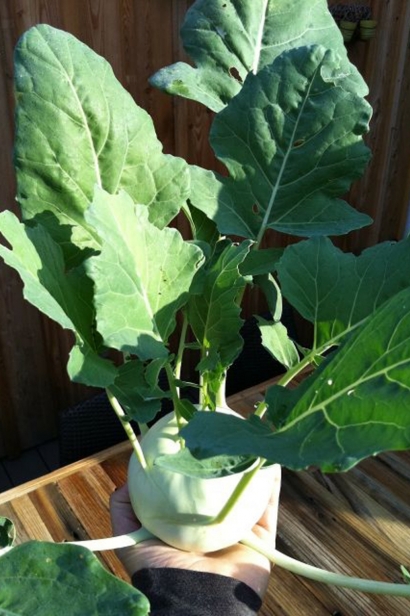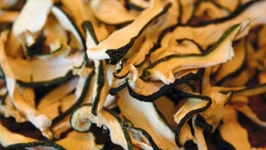Kohlrabi & Kitchen Ahimsa
I love farmers’ market season, but I don’t always ask about the unfamiliar vegetables I see displayed on the farmers’ tables. I walk away with my kale and beans and in-season fruit, bypassing a whole world of produce, like kohlrabi. I actually bought some kohlrabi the other day only to put it in the back of my fridge, claiming victory enough that it had crossed my threshold. Then I went to a yin yoga class where I had an epiphany about this cabbage relative: kohlrabi is the key to kitchen ahimsa.
Simple Surrender
Unlike the yoga of sun salutations, yin yoga incorporates mostly reclined poses held for 3-5 minutes. Rather than summoning the body’s yang or sun or heating energies, the practice cultivates the body’s yin or moon or cooling energies to help practitioners surrender to the poses. This word “surrender” is important. The poses are meant to nurture relaxation while still challenging yogis at a 6 or 7 on a sensation scale of 1-10, 1 being sleep and 10 being just too much. With lots of props like blankets and blocks and bolsters, a yin yoga class is an hour of psychotherapy for the body. It goes deep. And this time around, it got right down to my vegetable apprehension.
The first time I encountered kohlrabi, which can appear at the market through spring and again through fall, was at a market in Oregon, where a German friend of mine picked up a bunch and bit into one of the bulbs like it was an apple. He gave one to me, and I had to admit, it was nice—slightly sweet, but spicy-nutty as well, like apple, turnip, and broccoli all in one. It doesn’t look like any of these though. Kohlrabi’s round, bulbous bottom grows above ground and thins up to a stalk and leaves, all of which is edible.
Back to the vegetable therapy. Our teacher reminded us that in yin yoga, there is no set way a pose needs to look, because the practice is about surrendering. One person’s pose might require two bolsters and a blanket while another person might not use props. And that’s when it hit me: I can surrender to the unfamiliar vegetable. I can make it as simple and as easy as the vegetable itself. I can also use as many props as I need in the process.
Back to Basics
So I went home and beheld kohlrabi on my cutting board. I sliced the bulb and took a bite. I pinched off a leaf and munched. It came back to me—the taste was wonderful. What had I avoided for so long? I realized I could just EAT the kohlrabi. I sliced and medium-diced the rest of the bulbs and put them in Tupperware. I bagged the stems and leaves. Either of them I could snack on out of the fridge as-is or with a little hummus, if I wanted a simple prop. I had officially surrendered to the unfamiliar vegetable.
And then I thought of using other props: a steamer, a box of macaroni & cheese, and a go-to curry recipe. I brainstormed that I could steam the chopped kohlrabi bulbs like broccoli, mixing them into my toddler’s weekly macaroni & cheese with greens. And by shredding the left over stems and leaves, I could begin a familiar curry recipe that I base off of “fridge fixins,” still-good veggies that need using.
All of which brings us to ahimsa. As I reclined with my bolster and blanket at the end of yin yoga, balancing my relaxation with a sensation level of 6, the teacher reminded us of Sanskrit’s ahimsa, the practice of no-injury to any living thing, most importantly to ourselves. “How many times a day could we be kinder to ourselves,” she asked us. “What habits or actions or self-given messages could we alter,” she rhetorically probed. My mind played monkey and wandered from the mat:
“I’m not a gourmet chef” could become I like to make meals for my family.
“I can’t use unfamiliar vegetables unless I look up special recipes” could become I can familiarize myself with unfamiliar vegetables by eating them as-is or working them into regular recipes.
Well, heck, forget me. What about the kohlrabi?
“Kohlrabi doesn’t have a place in my family’s fare” could become Kohlrabi is yummy.
“Kohlrabi is too unfamiliar to me to be a part of any of our meals” could become Kohlrabi could be a new addition to tried-and-true family meals.
Wonderful gourmet recipes exist for kohlrabi and all the other less-familiar vegetables we encounter at the market. They use spices and oils and rinds and garnishes. I like to try these recipes. But for the nights when I don’t, which happen more often, I can still make the unfamiliar more of a regular. Check that. I can surrender to the simplicity of fiber and root and stalk and leaf that is the vegetable, no matter its name, no matter its look. That’s why, this time around, I leave you with no recipe but the one that you will discover.
Thank you, yin yoga teacher, for proverbially handing me a green bulb and saying, “Try it.”
So you too—try it!










